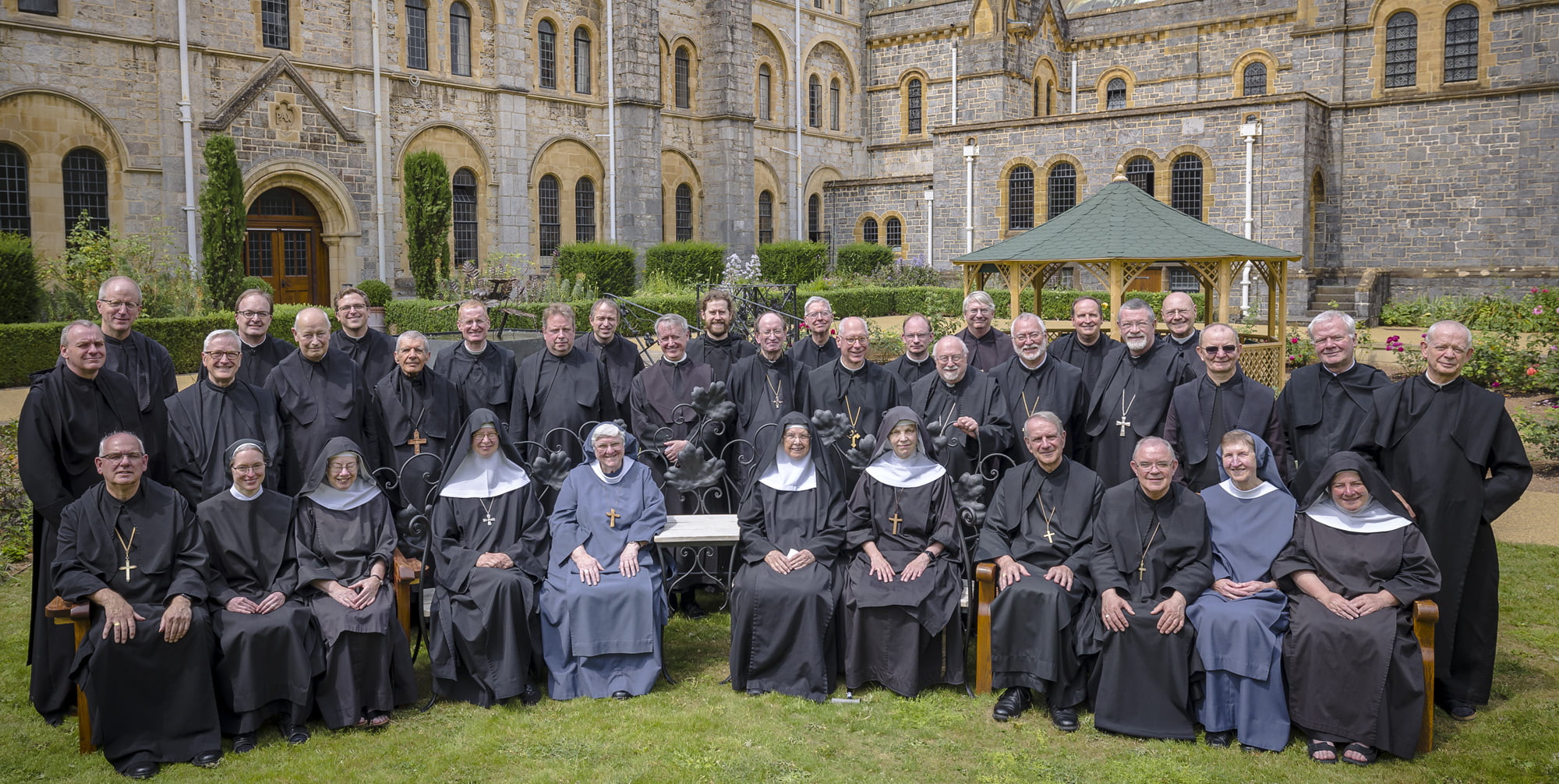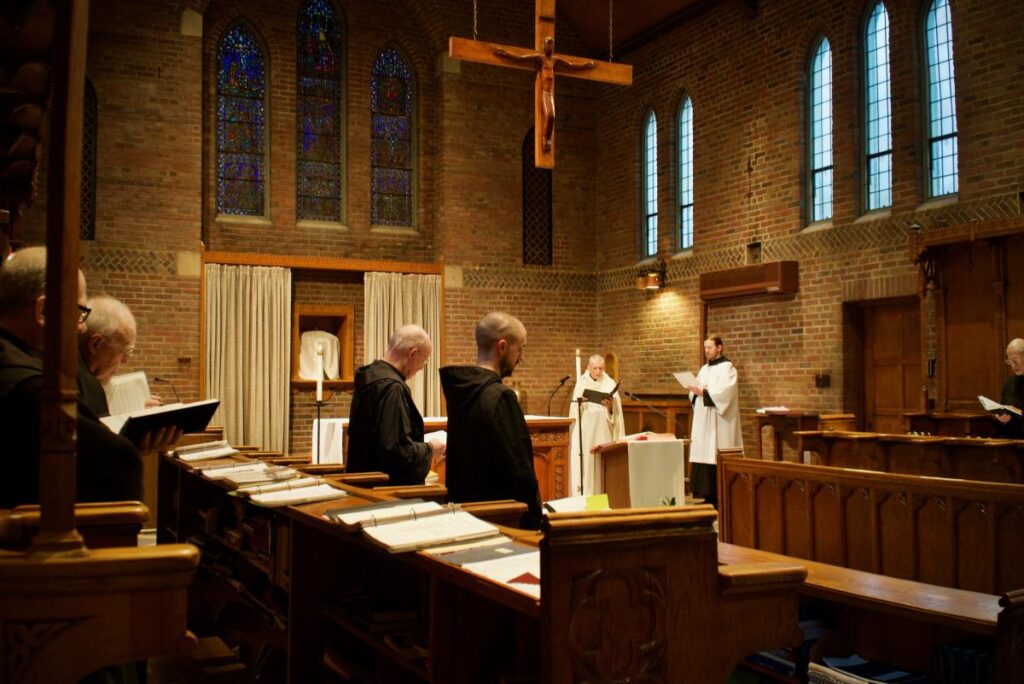

An oasis of peace
Welcome to St. Anselm’s Abbey
Washington, DC is a beautiful city, a city of parks and gardens, of historical monuments and museums, even as it is also a place where many people jostle for power and influence, where money, ambition, and prestige abound. Amidst all that and nestled on the city’s northeast boundary is our monastery, often called “an oasis of peace” by persons visiting for the first time. These guests are seeking a spiritual dimension in their life, something that is at the heart of what our monks experience day after day by following the Benedictine balance of prayer, work, and leisure.
Abbot James Wiseman, O.S.B.
History
Our monastic community began in an unusual way. Usually a “mother abbey” with a certain abundance of members decides to start a foundation in some other location, often in a different country. St. Anselm’s began in a very different way. In the early 1920s, a few men who were either diocesan priests or members of some particular religious congregation and who were teaching at the Catholic University of America wished to form a Benedictine community. This would allow them to combine traditional monastic life with their ongoing dedication to research and scholarship. Their admiration for the traditions of the Benedictines in the UK led them to approach the English Benedictine Congregation for sponsorship. After several unsuccessful inquiries, the four men, whose leader was Fr. Thomas Verner Moore, found the abbot of Fort Augustus Abbey in Scotland willing to accept them as novices.
After their year of novitiate at the Fort and accompanied by several Scottish monks to help them get started, including one who had been named their prior, they returned to Washington and on September 15, 1924, began residing in an old farmhouse about a mile from the university, with one of its rooms converted into a chapel. Over the course of the following year several other men expressed their intention of joining the community, making it necessary to make plans for a larger building. Diligent fund-raising permitted the purchase of some nearby land and the construction of a proper monastery and church. These two structures were dedicated in June 1930 and have been in use ever since.
Over the first one and a half decades of the monastery’s existence, it became clear that the original notion of a community whose work was dedicated primarily to research and scholarship was not financially viable, so plans were made to open a school for boys. The first class of students began their studies in the fall of 1942, using a wing that had originally been intended as a common novitiate for monks of St. Anselm’s and of Portsmouth Priory in Rhode Island, another new house in the English Benedictine Congregation. Over the years, the school grew in size and reputation as a place where boys of academic ability and dedication to learning could be thoroughly prepared for study at a college or university either in the United States or abroad. A separate school building opened in 1955, and additions have subsequently been made to it as well as to a gymnasium located at another site on the property, which still has enough wooded land to provide a home for deer, raccoons, foxes, and other animals. The school itself, originally a four-year high school, now has a three-year middle school as well, while the monastery was raised from the rank of priory to that of abbey in 1961. Shortly after that date, the Second Vatican Council (1962-1965) brought about significant changes in the community’s life, just as was the case throughout the Church. Originally our entire liturgy was in Latin, but now almost everything is in English, with music drawn from the work of composers from across the monastic world.
The center of the community’s life, as of any Benedictine monastery, is the church, where the daily Eucharist and Liturgy of Hours (called by St. Benedict “the Work of God” and often referred to as the Divine Office) are prayed at various times of the day, from early morning until nightfall. Our monks also follow the invitation of the Rule of St. Benedict that if at other times “a brother may wish to pray alone … he may simply go in and pray” (RB, chap. 52), and we also follow St. Benedict’s provision for extensive reading, which includes not only Scripture but also the works of authors ranging from the earliest Christian centuries up to the present day. The early monks of our community provided the seeds for what has become a truly magnificent library, with works not only on religious topics but on secular ones as well, including history, literature, and science.
Undergirding every aspect of our life is the spirit encapsulated in what many readers consider the most important chapter of the Rule, the seventy-second, which focuses on what the New Testament itself considers the principal Christian virtue—love. In that chapter, drawing directly on the teaching of the Gospel, St. Benedict asks the monks to live with a “good zeal” that is characterized by “fervent love.” He quotes St. Paul’s words about each one being “the first to show respect to the other” and goes on to say that this means “supporting with the greatest patience one another’s weaknesses of body or behavior,” so that after the monks have reached the goal of living with one another after the example of Christ, “he may bring us all together to everlasting life.” Everything else in St. Benedict’s Rule, including provisions for caring for the sick members and correcting faults when necessary, are directed toward that final goal. Even as we recognize our own various weaknesses, we now enter the second century of our community’s existence with gratitude to God and to the four men who came back across the Atlantic in 1924 to begin Benedictine life here in our nation’s capital.


St. Anselm’s Abbey
4501 South Dakota Ave., NE
Washington, DC 20017
Phone: 202-269-2300
For any enquires, please use the contact form below: